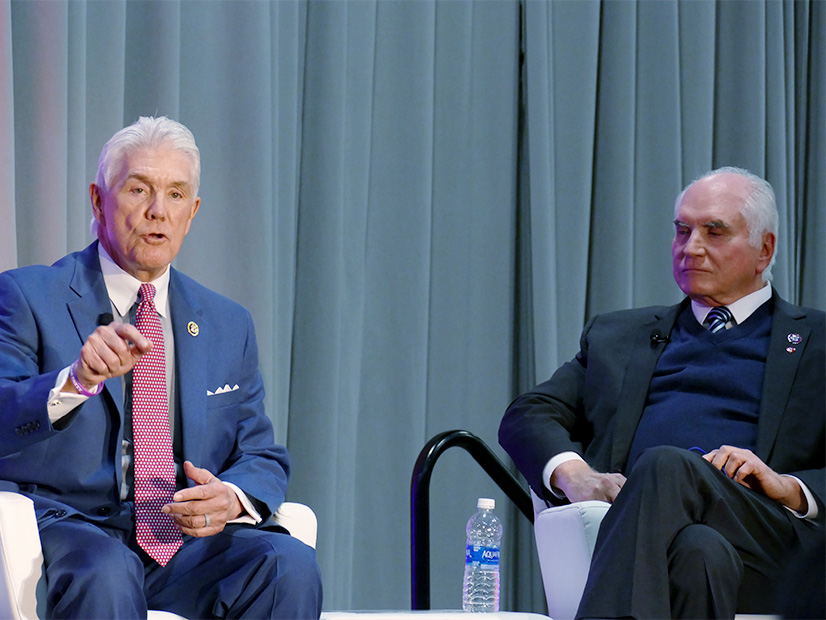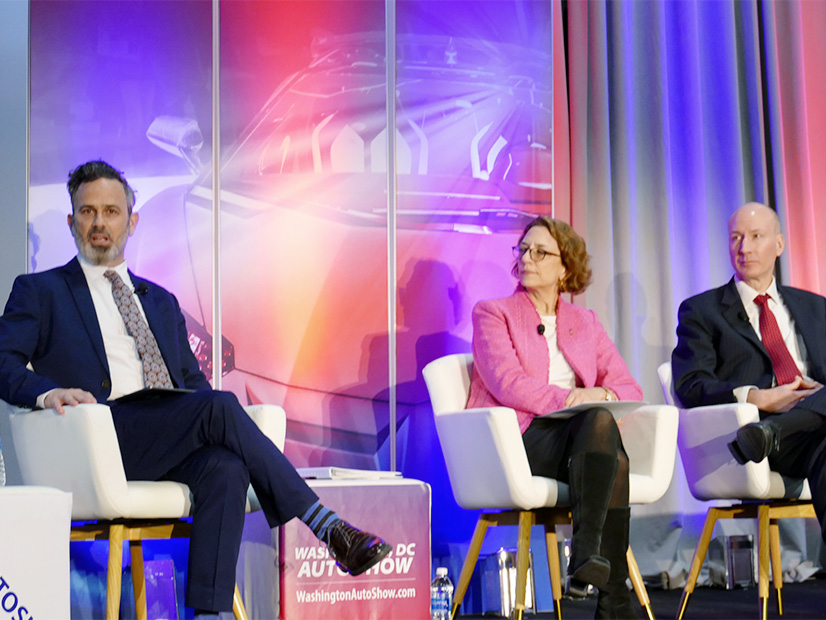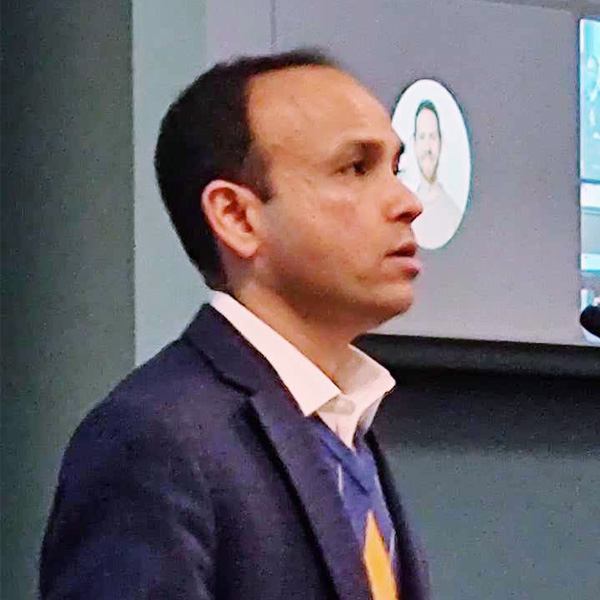WASHINGTON — Electric vehicles dominate the lower level of the Washington Auto Show, being held this week at the Walter E. Washington Convention Center, with Volvo showing off its EX90 SUV, Polestar displaying its $97,000 model 3 (zero to 60 in 4.6 seconds) and Hyundai offering test drives of its IONIQ 5 on an indoor track.
But those carmakers are chasing an illusion, U.S. Reps. Mike Kelly (R-Pa.) and Roger Williams (R-Texas) said during a panel discussion at the auto show’s Public Policy Day on Jan. 18.
“We see a situation where the manufacturer and the government are trying to shove these EV vehicles down people’s throats. They don’t want it,” said Williams, whose daughter now runs the dealership started by his father in 1939. “It’s a phony economy.”
Kelly agreed. “I don’t need people with more degrees than a thermometer to tell me what my market is. I’m there every day with them,” said Kelly, owner of Mike Kelly Automotive in Butler, Pa. “We should never force a market on anybody. If it’s market-ready, you don’t need to subsidize it.”
Williams and Kelly sparred with Reps. Debbie Dingell (D-Mich.) and Marcy Kaptur (D-Ohio) during the panel, with the Democrats defending the Biden administration’s goal of making EVs 50% of new car sales by 2030. In later appearances, White House National Climate Adviser Ali Zaidi and senior officials from the departments of Energy and Transportation also defended the administration’s policies.
“We are competing in the global marketplace. China is subsidizing their products every single day. And we cannot let them win,” Dingell insisted. “We have to invest in R&D. We are competing with other countries where the government makes the investment.”
EV Subsidies, Performance Criticized
Williams said EVs should be judged on their own merits, without subsidies.
“I’m not against EV vehicles, but I’m for competition. And we don’t have that right now,” he said.
Williams criticized EVs’ cold-weather performance and said they are particularly ill suited for a state as large as Texas. “When you go from Weatherford, Texas, to Midland, Texas, and you’re pulling a two-horse trailer or pulling a jet ski and a boat, [with] the EV vehicle you’re never going to make it. You’ll have a gasoline[-powered] truck come and get you and pull you back where you started from.
“I can live with a hybrid,” he added. “It’s kind of a real thing; we sell many in Texas. But … you can’t compare to an EV vehicle, because that’s a product that is not going to exist in a few years.”
Affordability
Kelly said the government’s EV push is evidence that Washington is out of touch with Main Street Americans. He recalled a customer visiting his dealership seeking to trade in a Chevy Volt. “It needed a new battery. The car was worth $11,000. The replacement battery was $10,000,” he said.
Deputy Energy Secretary David Turk acknowledged, “The affordability story is something that’s not breaking through as much.”
But he said federal research and development spending has helped reduce the cost of batteries by 90%, with a further 42% reduction expected by 2030.
“It’s incredibly exciting to see the [Chevrolet] Bolt under $20,000 [after the $7,500 federal rebate],” he said. “It’s incredibly exciting to see a variety of new models that are very cost-competitive, especially when you factor in the fueling; the fact that it only costs you $15 [to charge a battery] versus $46 [for a tank of gas].”
No Role for Mass Transit?
The panelists also clashed over the role of mass transit and how the U.S. compares with Europe on EV penetration and mass transit.
“This country, what made it great to begin with was our ability to go from point A to point B, and to get there by ourselves with just private transportation,” Kelly said. “Why the hell would we follow anybody from Europe and the path that they’re on when they rely on us for their very existence?”
“I don’t want to drive everywhere,” Kaptur responded. “I want … to have transportation options. We are very behind as a country in terms of road transportation, truck transportation and rail transportation. … We can’t live in 1950. We have to [prepare for] 2050. … We need a transportation revolution.”
Dingell said it’s the government’s role to lead the way on safety and environmental improvements.
“[Car] companies didn’t want CAFE [Corporate Average Fuel Economy] standards. Every consumer wants a more fuel-efficient car. … We didn’t want emission standards, and now everybody wants a cleaner environment. We didn’t want to wear safety belts; they’re saving lives. So sometimes when you’re doing what’s right, you’ve got to help educate.”
Charger Rollout, Reliability
The federal government’s charger buildout and reliability problems with existing chargers provided another flashpoint.
“I can tell you what a [public charging] station will look like. It’ll have graffiti all over it after a week and won’t be working. It will be broken,” Williams said.
Zaidi and Gabe Klein, executive director of the Joint Office of Energy and Transportation, said the U.S. has increased the number of public chargers to almost 170,000 from 73,000 in 2019. At the current installation pace, Zaidi said, the U.S. could reach its 2030 goal of 500,000 chargers three or four years early.
“We’re starting to see some improvement in the J.D. Power [reliability] numbers,” Turk said. “Just a couple of percent improvement over the last few months.”
“I feel like this coming year, we’re going to see a dramatic increase … in charging, reliability and availability,” said Deputy Transportation Secretary Polly Trottenberg, who joined Klein and Turk on a panel after the House members.
The Department of Transportation has created more than 40 new programs and awarded money to more than 40,000 projects over the last two years, Trottenberg said. “2024 is the year of project delivery,” she said. “Now our goal — and the EV charging projects are in that bucket — we have to make sure we get those projects up and running.”
Industrial Policy and the ‘Chicken-and-egg’ Dilemma
Turk defended federal subsidies as a response to the “chicken-and-egg” dilemma.
“In order to get the cost down, you need to get the scale. In order to get the scale, you need to bring the cost down. So what we’ve seen in country after country that’s made success in EV transitions is you’ve got to have some … intentional investment and do it in a very targeted way to get to scale that then brings the cost down.”
Zaidi said funding from the Inflation Reduction Act, Infrastructure Investment and Jobs Act and CHIPS and Science Act of 2022 has used billions in private investment, including more than 40 factories with a combined capacity of 1 million chargers a year. “So that’s the transformational scale I think that we have unleashed,” he said. “And this isn’t some sort of pie-in-the-sky concept. We’re seeing steel go in the ground.”
“The future of automotives is electric plug-in hybrid, battery electric, hydrogen electric,” Zaidi continued. “The president’s policies have made the United States the [No. 1] destination for private investment to write the next chapter of automotive history here with our workers.”
Turk said federal funding has used $157 billion of private investment for EVs and batteries, with 340 new or expanded facilities producing 136,000 direct jobs. “That’s a remarkable amount of funding, even in an economy as big as our economy.”
“I grew up in a steel mill community in which the jobs just went away,” Turk continued. “If you want to … just sit there and watch all those jobs go to China, that’s one approach. The other approach is you use the tax incentives, you use the grants, you use the loans, you have an industrial strategy and you play offense. And that’s what we’re doing right now.”
Joseph Pittel, vice president of legal and public affairs for Samsung SDI, said tax credits from the IRA were “a critical component” of his company’s decision to invest $9 billion in the U.S., including two battery factories in Kokomo, Ind., and an expanded battery factory in Auburn Hills, Mich.
“That’s money we put on the table that would not be on the table, but for the policy,” he said during a panel on supply chain issues.
AM Radio
Toward the end of the House members’ discussion, Dingell offered the Republicans “something every one of us agrees on. And this is AM radio. … I want it in my car.”
The cowboy boot-wearing Williams agreed. “It’s the only one that plays my kind of music,” he said.




